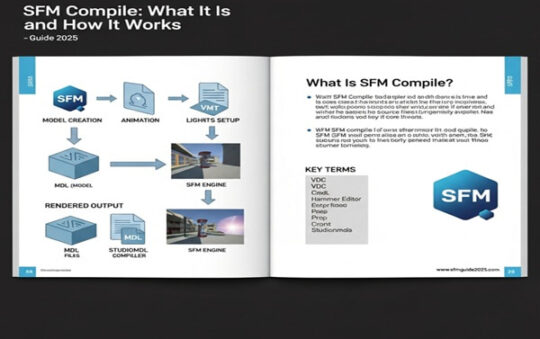Have you ever felt like your apps, devices, and tools just don’t play nicely together? You jump from one tab to another, send messages across three different platforms, and somehow still miss an important update. That’s not just annoying—it’s costly. Studies show that 5% of daily productivity loss comes from poor communication and tool misalignment.
That’s exactly what sinkom was built to solve.
Short for Sync + Communication + Modules, sinkom is more than a buzzword—it’s a smarter way to organize your digital life. It helps your tools talk to each other, your team stay coordinated, and your time get spent where it actually matters. No more repeat work. No more lost files. And definitely no more wondering who’s doing what.
This guide will walk you through what sinkom means, how it works in real life, and how you can start using it—whether you’re a student juggling assignments or a business owner trying to streamline workflows.
Contents
What Exactly Is Sinkom?
At its core, sinkom stands for three connected ideas:
Sync. Communication. Modules.
Let’s break that down in simple terms:
-
Sync – Everything updates automatically. Change one thing, and it reflects everywhere else.
-
Communication – Tools and people stay on the same page through messages, alerts, and updates.
-
Modules – Think of it like LEGO for your workflow. Each piece (or app) fits together smoothly, and you can rearrange them however you like.
The goal? To make your systems smarter, simpler, and more connected.
Where Sinkom Came From—and Why It Matters
As work, school, and even homes started relying on multiple digital tools, people began noticing a problem: everything was scattered. Messages in one app, tasks in another, and notes hiding somewhere in the cloud.
That’s how sinkom came to life—a concept born out of frustration and innovation. It blends ideas from modular systems, service-oriented architecture (SOA), and lean communication models to create a connected digital ecosystem.
When remote work and automation started booming, the need for something like sinkom became even clearer. It bridges gaps between systems, reduces clutter, and restores clarity across your devices, apps, and teams.
The Three Pillars That Make Sinkom Work
Sinkom is built on three strong pillars that define its magic:
1. Synchronization
This is all about timing. When a change happens in one place, it instantly updates everywhere else.
Example: when someone completes a task in your shared project board, everyone sees it right away—no extra messages needed.
2. Communication
Good communication is more than just chatting. It’s about sending the right info to the right people at the right time—whether it’s a task alert, project update, or automatic reminder.
3. Modularity
Imagine your work setup as a set of building blocks. Each block (app, file, or process) has its own function, but all fit together neatly. That’s modularity—flexibility without chaos.
Sinkom vs. Traditional Systems
Old-school systems often trap you in silos. You use one app for emails, another for files, another for tasks—and none of them “talk.” That means extra work, missed updates, and lots of confusion.
Sinkom flips that script. It connects tools through smart syncing and communication, turning your disconnected workflow into one cohesive system.
Think of it like the difference between:
-
A conveyor belt (traditional systems) — rigid and repetitive.
-
A drone swarm (sinkom) — agile, adaptive, and fully aware of its surroundings.
Key Features That Make Sinkom Stand Out
-
Real-Time Syncing: Updates happen instantly across devices.
-
Cross-Platform Support: Works smoothly with your favorite apps.
-
Customizable Modules: Add or remove features as needed.
-
Scalable Design: Grows with you—from individuals to entire teams.
-
AI-Ready Framework: Integrates easily with smart systems and automation tools.
Why Sinkom Matters for Everyone
Most people don’t realize how much time they waste juggling unconnected tools. Sinkom brings back flow and focus by cutting out the noise.
Here’s what it helps you do:
-
Eliminate repetitive tasks
-
Avoid missed messages or updates
-
React quickly when things change
-
Use your favorite apps without friction
Whether you’re managing a classroom, a company, or your household, sinkom keeps everything moving in sync.
Real-Life Examples of Sinkom in Action
Example 1: The Small Business Fix
A bakery takes online orders through Google Forms. Each order automatically updates a spreadsheet, sends a text to the kitchen, and creates a task for the baker—all without manual input. That’s sinkom at work.
Example 2: The Student Project
A group of students connects Google Docs, a messaging app, and a shared calendar. When someone updates a deadline or uploads a file, everyone knows instantly. No confusion, no chaos.
Example 3: The Smart Home Setup
Unlock your door, and your lights turn on. Your thermostat adjusts automatically. Coffee starts brewing. That’s sinkom in your home—modules syncing to make life easier.
How to Start Using Sinkom
Here’s how to set up your own sinkom system step by step:
-
List Your Tools: Write down what apps or devices you use daily (email, calendar, task manager, etc.).
-
Spot the Gaps: Identify where you’re manually moving information between systems.
-
Connect Everything: Use automation tools like Zapier, Make, or IFTTT to link apps.
-
Create Shared Spaces: Set up collaborative dashboards or chat channels.
-
Think Modular: Break big goals into smaller, connected parts.
Practical Use Cases for Sinkom
-
Education: Students syncing assignments, notes, and deadlines.
-
Healthcare: Doctors and nurses updating patient data in real time.
-
Small Businesses: Automating inventory, scheduling, and messages.
-
Remote Teams: Managing projects across countries and time zones.
-
Smart Homes: Connecting lights, thermostats, and appliances.
Common Challenges You Might Face
Sinkom sounds great—and it is—but setup can have its bumps. Here’s what to watch for:
-
Too Much Syncing: Over-automation can flood you with alerts.
-
Privacy Risks: Always check permissions before linking tools.
-
Integration Hiccups: Some platforms don’t play nice right away.
-
Workflow Complexity: Start small to avoid messy connections.
Remember, simplicity beats perfection when starting out.
Also Read : Prizmatem Modular Innovation for Design, Learning & Tech
Tools That Work Best With Sinkom
-
Zapier – Connects popular apps automatically
-
Slack – Team chat and instant notifications
-
Notion – Modular workspaces for all kinds of projects
-
Google Workspace – Seamless syncing across Docs, Sheets, and Calendar
-
IFTTT – Connects smart devices and mobile actions
You don’t need them all—just pick the ones that fit your lifestyle.
Common Myths About Sinkom
“It’s only for tech experts.”
Nope. If you can use email or a phone, you can use sinkom.
“It’s expensive.”
Many tools offer free plans or built-in integrations.
“It’s just automation.”
Automation is part of it, but sinkom also focuses on communication, structure, and collaboration.
Next-Level Sinkom Strategies
Once you’ve mastered the basics, try these:
-
Custom Workflows: Set triggers that update reports or notify teams.
-
Use Webhooks: Exchange data automatically between tools.
-
Track Performance: Create dashboards to measure productivity.
-
Stay Secure: Review who has access to your synced systems.
The beauty of sinkom is scalability—it grows with your needs.
The Future of Sinkom: Smarter, Faster, More Predictive
As AI and smart devices evolve, sinkom is moving toward predictive syncing. Imagine your system noticing gaps before they cause delays—or updating dashboards before you even ask.
Upcoming trends include:
-
AI-based behavioral syncing
-
IoT and smart city integration
-
Predictive task recommendations
-
Seamless multi-device coordination
Sinkom isn’t just a tech upgrade—it’s the foundation for how digital ecosystems will function next.
How Sinkom Helps Different People
-
Students: Stay on top of projects and deadlines with synced calendars and reminders.
-
Parents: Keep family events, grocery lists, and chores aligned.
-
Remote Workers: Manage projects and chats in one unified flow.
-
Creators: Automate posting, saving, and replying—so you can focus on creating.
Is Sinkom Right for You?
Ask yourself:
Do you use more than three apps daily?
Do you copy-paste info between systems?
Have you ever missed an update or task?
Do you want simplicity without losing flexibility?
If you said yes to at least three, sinkom can transform your workflow.
Sinkom: Not Just a Tool—A Mindset
Sinkom isn’t a passing tech fad. It’s a way of thinking—about connection, clarity, and flow.
You don’t have to overhaul your entire setup. Just start small: link one tool to another, automate a single task, or invite someone into a shared space. Once you feel the difference, you’ll never want to go back.
That’s the power of sinkom—simplify smarter, connect better, and get your time back.




